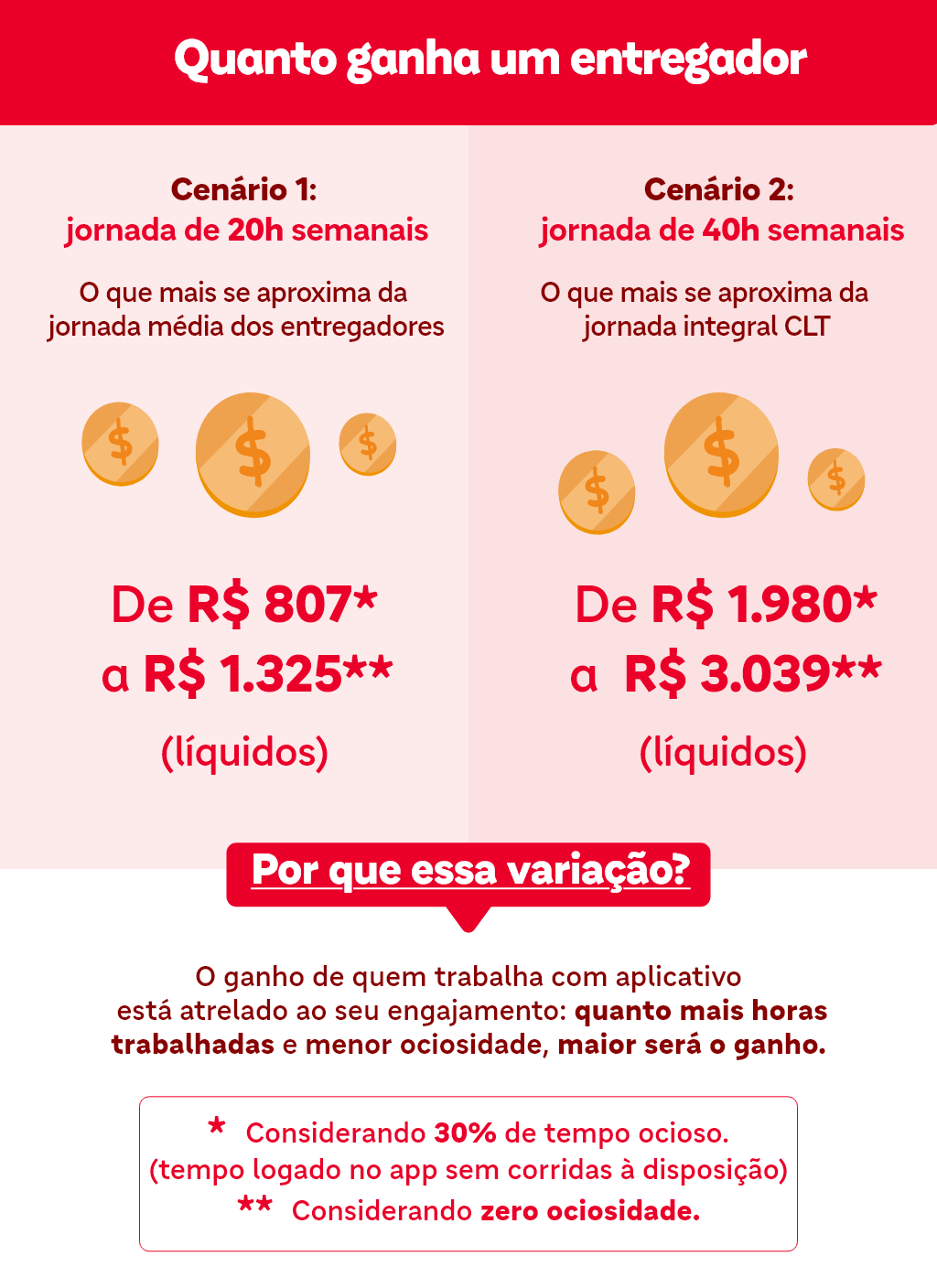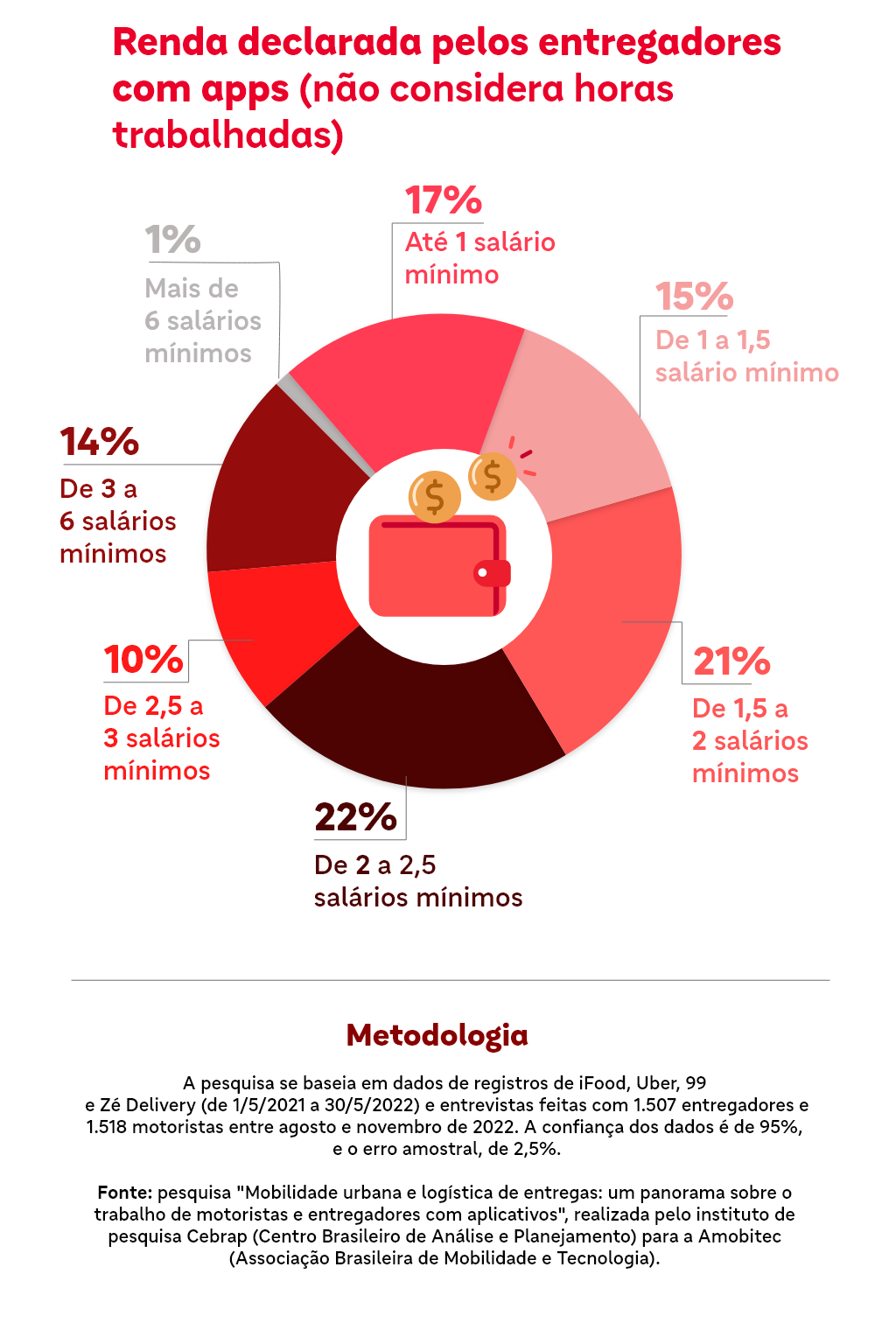An unprecedented survey sheds light on how much an app delivery person earns in Brazil, essential information for the debate on the regulation of work on platforms.
Using data provided by members of Amobitec (Brazilian Mobility and Technology Association), such as iFood, 99, Uber and Zé Delivery, the research “Urban mobility and delivery logistics: an overview of the work of drivers and delivery people with apps”, carried out by Cebrap (Brazilian Center for Analysis and Planning), calculates the average earnings of these workers.


For those who work with applications, this amount is not fixed, as their earnings vary depending on their engagement at work, which makes it difficult to perceive monthly earnings.
In the case of delivery drivers, a factor that needs to be taken into account is that dedication to the app is not always exclusive: almost half of these workers (48%) carry out another professional activity concurrently with delivery apps, according to the research.
Therefore, the study estimated the monthly income of delivery drivers taking into account Amobitec's administrative records and the variation in both hours worked and idleness, since delivery drivers are not active during the entire time they are logged into the application. They may, for example, be waiting for an order or even be involved in other economic or daily activities.
To estimate this income, Cebrap took into account two scenarios: one of a 40-hour shift per week, including idle times of 10%, 20% and 30%, and another of a 20-hour shift, including the same idleness margins.
For a 40-hour work week, the research estimated a net income that varies between R$ 1,980 (idleness of 30%) and R$ 3,039 (idleness of zero).
More about Cebrap research
- Research profiles app deliverers
- Research shows how much an app delivery person works
- What is the perception of the work of delivery people on apps
“It is always very difficult to talk about monthly earnings on digital platforms because the work is not recurring in nature”, explains Debora Gershon, head of iFood public policies. “The exercise carried out by Cebrap, in this sense, is quite interesting, because it takes part of the hours actually worked on the platforms and adds to them a type of waiting time for receiving an order.”
She points out that, even in the worst idle scenario, in which waiting time can correspond to 30% of the total time in activity, the research shows that the remuneration of delivery drivers who work 40 hours a week is above the national minimum wage. “This is an important starting point for discussing improvements”, he adds.
For a 20-hour workweek, which is the closest to the average workday measured by the research (13 to 17 hours per week), it is estimated that the net income of a delivery person varies between R$ 807 (with idle time of 30% ) and R$ 1,325 (no idle).
Between 2021 and 2022, iFood made three minimum earnings adjustments, following its public commitment to evaluate, at least once a year, the need to adjust delivery charges.
How much does a delivery person earn per hour?
Debora draws attention to another piece of data from the research: the one that calculates the amount received per hour in activity, that is, while the delivery person is actually making the delivery. The average measured by the research is R$ 23 net per hour worked — four times higher than the minimum wage per hour (R$ 5.5).
“Delivery drivers’ earnings are linked to the hours spent on the app. Any discussion we have about earnings, and we need to do so, needs to consider this reality of the sector”, he comments.
“If we only consider, for example, the fact that a delivery man or delivery woman can receive an average of R$ 807 per month without asking ourselves about the number of hours he or she dedicates to the platform, we will not be having a productive discussion. The discussion about gains needs to be linked to the diagnosis of engagement”, he says.
When asked about their income from working with applications, 68% of the 1,507 delivery drivers interviewed in the survey declared to earn between 1 and 3 minimum wages — equivalent to an amount between R$ 1,212 and R$ 3,636, considering the value in force in 2022, when the survey was carried out .
The values obtained in the study carried out by Cebrap also show a higher remuneration for app couriers in relation to the earnings recorded in the PNAD COVID 19, which had an average monthly remuneration value of R$ 1,696 for couriers who worked on and off the platforms.
This is not only because the values were collected in different years, but also, most likely, because the IBGE survey covers a broader profile, including delivery drivers who do not work with intermediation applications.
“In addition, some comparisons with both the COVID 19 PNAD and the Continuous PNAD for related groups both in terms of occupation and education, showed that income from applications tends to be higher than those observed in the national average.”
Although further research is necessary to better understand the scenario, Debora comments that this data alerts us to the working conditions of non-platformed couriers.
“We do not have data to advance the debate about the gains of independent couriers who do not work with the applications and we know that the comparison with the PNAD is merely illustrative, due to the methodological differences and time frame. But if average earnings tend to be higher when we look at platform couriers in particular, this should be a point of attention in the public debate.”


